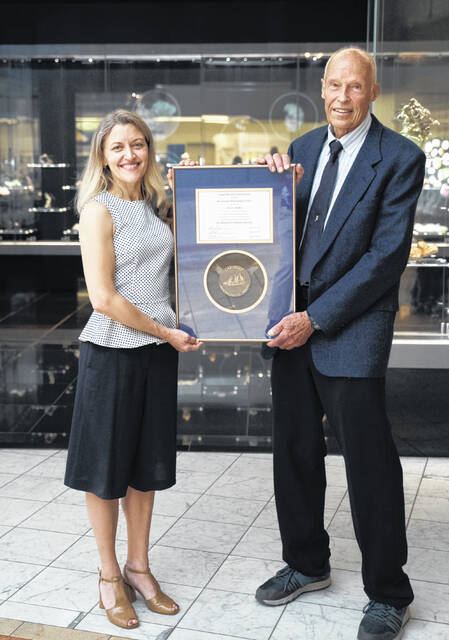
The Carnegie Museum of Natural History has awarded Dr. John C. Medici with its 2020 Carnegie Mineralogical Award. Medici, who has lived in Ostrander for 24 years, is the 33rd recipient of the award that began in 1987. The award honors outstanding contributions in mineralogical preservation, conservation and education.
“John Medici is an excellent choice for the 2020 Carnegie Mineralogical Award,” said Travis Olds, assistant curator of minerals, section of minerals and earth sciences at Carnegie Museum of Natural History, in a release. “His contribution to the mineral community has been significant, but his greatest contribution to specimen mineralogy is his dogged pursuit of top-quality specimens in the field, specimens that would otherwise be destroyed by industry or nature.”
Due to the pandemic, which canceled the Tuscon Gem and Mineral Show where the award is usually presented, Medici was honored during a virtual award presentation earlier this year.
“I’ve been honored, and I’m a little overwhelmed with being nominated for the Carnegie Mineralogical Award,” Medici said during his acceptance speech. “I’m a little bit surprised because I’m not in academia, I’m not a museum curator, and my business is not minerals. I don’t make my living in minerals. I never took a geology or mineralogy course. But the fun in our family is getting out and doing the Easter egg-type field collecting.”
Medici, who first moved to Dublin when he began working at Chemical Abstracts Service in Columbus, told The Gazette the Carnegie Mineralogical Award is the most prestigious award he’s ever received, and he’s “kind of proud of it” considering he’s not even a mineralogist.
Medici said his interest in minerals first began with the stone walls his father used to build his childhood home in New Jersey. With an interest sparked, he said his mother “followed up on that” by taking him to the American Museum of Natural History and various places around New Jersey, a state he called “a wealth of minerals.”
While hunting minerals has proven fruitful for him, Medici said he laments not getting involved in collecting sooner. He said various athletic hobbies, including skiing, hockey, and swimming garnered most of his attention prior to collecting. Medici said he did “a lot of pretty serious swimming” while going through graduate school to earn his Ph.D. in biochemistry at Rutgers University, which included ocean swims and swimming across the Hudson River.
“When I quit swimming, I was really fidgety because I was swimming three-and-a-half miles per day in interval training, which is a lot of energy,” Medici said.
The father of a fellow swimmer and friend to Medici was an avid rock collector, and it was his suggestion that Medici begin collecting carnelian, which is abundant in parts of New Jersey. It was also suggested to Medici that he “begin swinging hammers and doing chisel work” to hunt quartz crystals — known as Herkimer diamonds — in New York.
“I jumped in with both feet during my last couple of years in grad school. Things went on from there,” Medici said.
Out of school, Medici’s first big job opportunity came in Baltimore, working with the space program in extraterrestrial life detection. During his time in Baltimore, Medici said he really got into fossil and mineral hunts and even had a couple of “major finds” that included a turquoise crystal. His biggest find, he said, was a 60-foot tube of prehnite and apophyllite uncovered in a fault zone of a quarry. It was that find that Medici said solidified his interest in minerals.
“I’ve had all kinds of minerals that I have found, including a bunch of Canadian minerals. I’ve been all over Canada, too, up in the artic, even,” Medici said.
Prior to receiving the award, Medici’s articles and photos have also been featured in both The Mineralogical Record and Rocks & Minerals, the two most prominent mineral publications. He has also co-authored two chapters on Herkimer diamonds in the book “American Mineral Treasures” along with one of his sons.
Asked what the biggest allure of hunting minerals and fossils is to him, Medici said he most enjoys getting out and being a part of nature. Many of his finds have been donated to various museums for the public to enjoy.
To hear Medici’s full acceptance speech, visit the Carnegie Museum of Natural History’s Youtube page.


